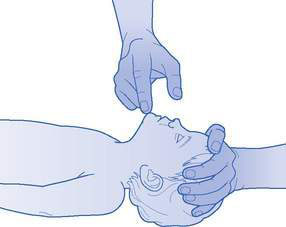5.2 Resuscitation
Diagnosis
Collapse may occur because of: a primary neurological process; loss or reduction of oxygen supply to the brain; or a metabolic disturbance or toxins affecting brain function. Collapse may be the result of many different disease processes, some examples of which are shown in Table 5.2.1. A more thorough differential diagnosis and approach to assessment of the collapsed child is presented in Chapter 5.1.
Table 5.2.1 Some causes of collapse in children
| Category | Diagnosis |
|---|---|
| Primary neurological process | Meningitis Head injury Encephalitis Seizures |
| Failure of oxygen supply to brain | Acute asphyxia (e.g. drowning, birth asphyxia) Respiratory causes (e.g. severe asthma, croup) Cardiac causes (e.g. arrhythmias, myocarditis) Hypovolaemia (e.g. dehydration, haemorrhage) Sepsis Anaphylaxis |
| Metabolic disturbance or toxins | Hypoglycaemia Hyponatraemia Drug or other toxic ingestion Envenomation Bacterial toxins |
Resuscitation
Resuscitation techniques for newborn infants are discussed in detail in Chapter 11.1.
Life support
Quickly evaluate the degree of collapse:
Airway
If the airway is completely or partially obstructed, it may be further improved by extending the neck to the neutral, or slightly extended, position, and supporting the jaw in a forward position; this is easiest done with the child on their back (Fig. 5.2.1). This may be done by placing your fingers behind the angle of the mandible and applying gentle forward pressure. If secretions, gastric contents or food may be obstructing the airway, suck them out, preferably with a wide-bore rigid sucker.
Stay updated, free articles. Join our Telegram channel

Full access? Get Clinical Tree



